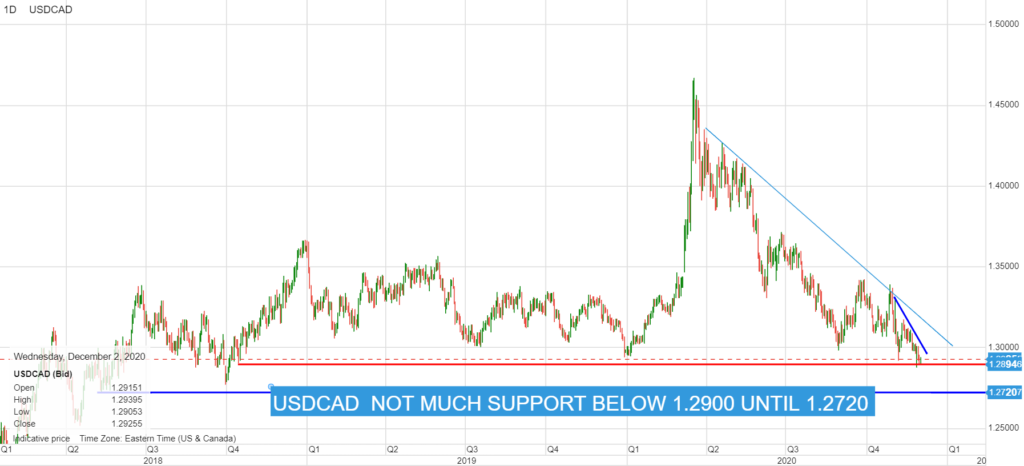
Photo: Wikimedia commons
December 3, 2020
USDCAD open (6:00 am ET) 1.2929-33, Overnight Range 1.2906-1.2939
- Brexit deal rumours boosting GBPUSD (again)
- US COVID-19 stimulus chatter supporting “risk-on” sentiment
- US dollar extending losses in early NY trading
FX Ranges at a Glance:

Source: IFXA Ltd/RP
FX Recap and Outlook: US weekly Jobless claims were a better than forecast (actual 712,000 vs forecast 775,000), but the results were a non-factor for FX markets. Instead, the focus is on Brexit, and the surge in GBPUSD which helped sink the US dollar against the G-10 major currencies.
GBPUSD is attracting buyers like sots to an open bar. The media is rife with rumours of pizza-fueled, late-night meetings with rumours of concessions from both parties raising hopes for a deal as early as this weekend. The Chief Negotiator Michel Barnier said the next 48-hours would be crucial. The Irish Foreign Minister said there was a good chance for a deal. GBPUSD climbed from 1.3355 in Asia to 1.3465 in NY. News that the UK Services PMI index rose 47.6 from 45.8 didn’t hurt sentiment.
Asia FX markets traded cautiously, with the Antipodean currencies getting a small lift from the better than expected China Caixin Services PMI data. Hopes for a new US COVID-19 relief stimulus proposal also underpinned positive risk sentiment.
Asia equity indexes were uninspiring. The major Japanese indexes closed nearly unchanged, while the Hong Kong Hang Seng rose 0.74% and Australia’s ASX 200 Index climbed 0.38%. European bourses are mixed. The FTSE 100 is up 0.28% at mid-day in London, while the German DAX is down 0.44%. US equity futures are flat.
Oil prices took a turn for the worse following rumours that Opec and friends will approve a 500,00 barrel/day production increase, effective January 1. WTI dropped from $45.46/b to $44.69/b. The move was short-lived as the increase is just 25% of the existing production cuts. Prices rebounded to $45.23/b in NY.
EURUSD traded with a modestly bullish bias, rising from 1.2102 in Asia to 1.2139 at the European open, then back down again. Things changed when NY opened, and the single currency surged to 1.2161. The rally was fueled by rumours of an EU/UK trade deal, broad-based positive risk sentiment thanks to coronavirus vaccines, and renewed US COIV-19 stimulus chatter.
However, EURUSD is becoming extremely overbought on daily technical charts. Prices are vulnerable to a correction in the run-up to next week’s ECB meeting.
USDJPY peaked at 104.70 on Wednesday and has drifted steadily, and orderly lower, touching 104.03 in NY.
AUDUSD and NZDUSD are riding the positive risk sentiment wave, with an assist from the recent slate of better than expected China data. AUDUSD traders continue to ignore hostile China trade actions against Australian imports.
USDCAD dropped alongside gains in the antipodean currencies. Traders are ignoring domestic fundamentals, particularly the ballooning budget deficit, and ongoing COVID-19 outbreaks. UK Chancellor of the Exchequer Rishi Sunak warned that the UK’s GBP deficit of 376 billion (CAD 653.0 billion) would be “unaffordable” if interest rates rise. Why isn’t the Canadian government concerned?
USDCAD Technicals: The intraday USDCAD technicals are bearish below 1.2940, looking for a break of sup[[port at 1.2900 to extend losses to 1.2850. The medium term technicals are bearish below 1.3200, looking for a break below 1.2900 to extend losses to 1.2720. For today, USDCAD support is at 1.2905 and 1.2870. Resistance is at 1.2960 and 1.2980. Today’s Range 1.2905-1.2980
Chart: USDCAD daily

Source: Saxo Bank
FX open (6:00 am EDT) High, Low, and previous close

Source: Saxo Bank





